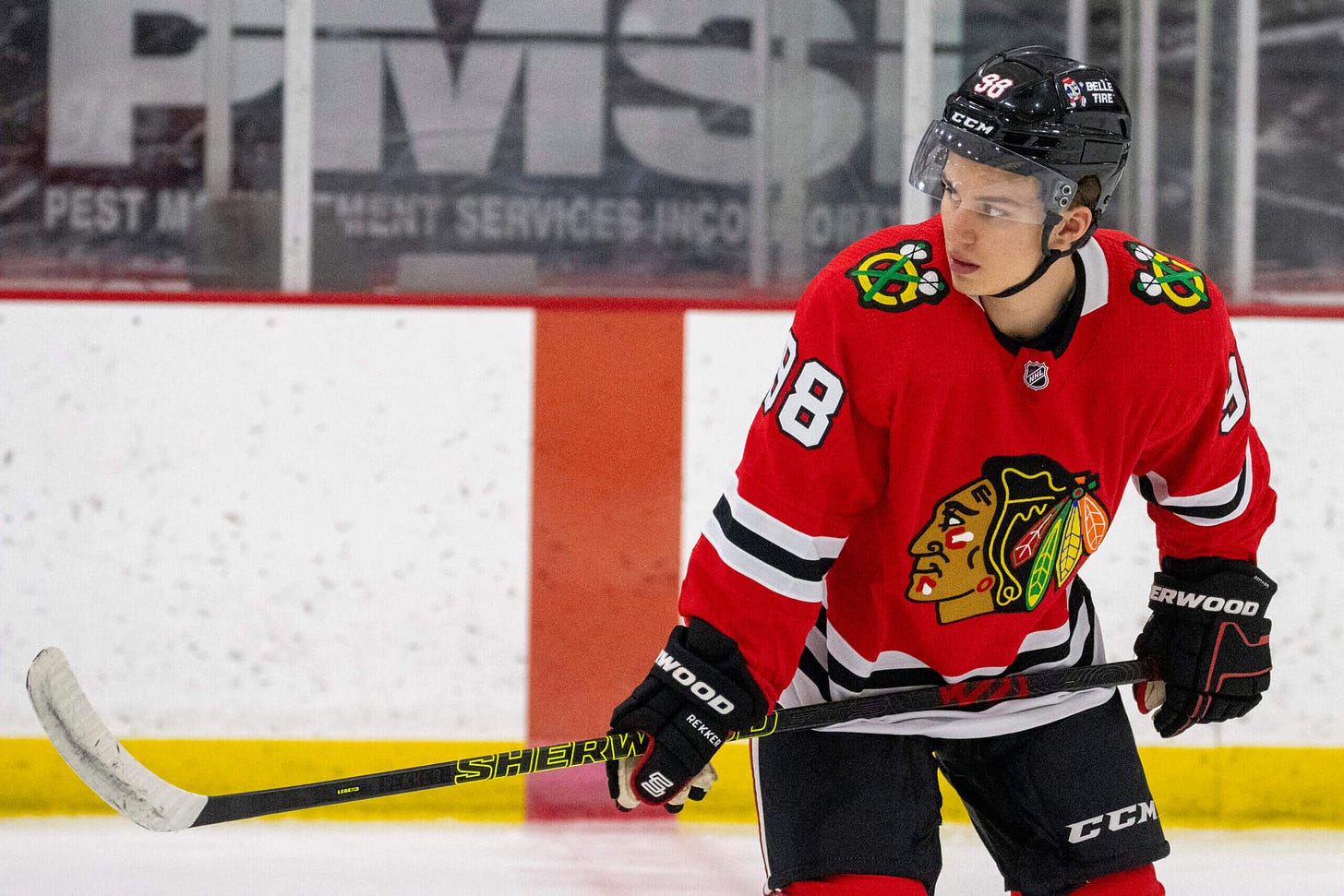First Impressions: Bedard, Carlsson & Fantilli
A closer look at the 2023 draft's top three picks

Since it’s still too early in the 2023-24 season for a proper deep dive, let’s take this opportunity to check in on the most recent first (Connor Bedard), second (Leo Carlsson) and third (Adam Fantilli) overall picks.
As someone who almost exclusively watches the NHL—and thus hasn’t seen these players in action beyond the WJC—here are my first impressions.
Note: Carlsson’s video is shorter than the others because he’s only played two games to this point. Anaheim has opted to ease its rookie into the mix.
Connor Bedard (1st overall, CHI)
Much like former Blackhawk Alex DeBrincat, Bedard’s (4 points in 7 games) offense is built around his spacing and first touch. Whether he’s on or off the puck, he displays a keen understanding of how to arrive on time. He isn’t ranked 12th leaguewide in expected goals by happy accident. Skating himself free comes naturally.
He also possesses a good feel for the flow of traffic, often working scissor designs with his strong-side defenseman to get Chicago moving downhill. We see this in both extended cycle situations and transition, as he’ll stop up and initiate rotations for his squad.
Though he was billed as a generational scorer, he’s a gifted playmaker in his own right. Excellent vision, velvety touch, very little stubbornness in his game. He exploits the cross-ice seam effectively on the PP.
Moreover, Bedard’s quite comfortable with finding cheeky passing angles on his backhand. This is important because his wrist shot’s reputation precedes him. Defenders will try to nullify his forehand.
His top speed is merely decent. However, his side-to-side elusiveness and deceptive hands allow him to manufacture breathing room against defenders in one-on-one scenarios. His dekes tend to cover a lot of ground, which can soften the limitations of his 5’10” build.
Bedard is realizing that the long-distance drag shots that mystified junior goaltenders aren’t troubling NHL netminders nearly as much. Consequently, he’s becoming a bit more selective and beginning to lurk closer to the net. Incorporating more one-timers—or simply attacking with pace—could help open the floodgates.
A high-end distributor wouldn’t hurt either. His most common linemates have been Ryan Donato, Taylor Hall, Taylor Raddysh, Tyler Johnson, Andreas Athanasiou and Nick Foligno.
Leo Carlsson (2nd overall, ANA)
Carlsson’s (1 point in 2 games) biggest strength is his processor. He senses where his opponents and teammates are at all times and can therefore smell weaknesses in coverage or outlets that most cannot.
He also buys into the team concept as a passer. We’re only two games into his career, but he’s done a stellar job of involving trailers and point men in the proceedings. Anaheim’s five-man interplay vastly improves when he’s on the ice, slinging the puck around to apply pressure from various areas of the OZ.
There’s no ignoring his 6’3” frame. Although he could stand to pack on another ~10 pounds of mass, the rookie’s range is giving defenders fits in the trenches. He regularly emerges from the pile with the puck on his stick.
Carlsson is a well-rounded offensive weapon who can effortlessly switch between passing, shooting and net-driving mode. His patience and long reach enable him to shift the point of attack in tight as well. The building blocks are there for a finesse-oriented, dual-threat power forward (e.g. Mikko Rantanen).
Thanks to his IQ, he doesn’t usually need to turn on the jets. When he does, he’s quicker than he lets on. His blend of size, mobility and puck skills means he’s on top of you in a millisecond. Despite his surprising wheels, he never looks rushed out there. He can play fast…slowly.
So far, he’s been deployed as a net-front man on the power play. If the coaching staff insists on slotting him below the dots, it should place more emphasis on goal-line passing than screens/tips/tap-ins. He’s a playmaker. Let him make plays.
Adam Fantilli (3rd overall, CBJ)
Fantilli (4 points in 6 games) is a phenomenal skater who can slash through the NZ in his sleep. Unless he’s playing with Johnny Gaudreau, Columbus should entrust the rookie with zone entry responsibilities (similarly to how Jack Hughes and Jesper Bratt operate on different units in NJ). Feed him the puck early and often.
Beyond his straight-line speed, there’s potential for a demon down low. He’s a bit too deferential at the moment, but as his confidence rises, don’t be surprised if he introduces more wiggle to his craft, stopping and starting on a dime to create separation.
The 19-year-old is a shoot-first center who gets a ton of velocity on his wrister. Furthermore, he cleverly changes his release point—perhaps not as dramatically as Bedard does, but enough to whistle the puck past the first wave of defense.
Due to his prowess on the rush and eagerness to pull the trigger, Fantilli ranks 14th in expected goals. He’s been nearly as dangerous as Chicago’s budding star, albeit in more of a mid-range capacity.
He’s a capable passer too. While there isn’t ample sauce in his repertoire, his crisp and direct setups do the trick.
For all his raw talent, Fantilli seldom cheats the game. He’ll gladly roll up his sleeves and battle for pucks in the corners. When you consider his overall style (the motor, toolkit, etc.), think Matty Beniers on steroids. More explosive, more creative, a smidge less responsible.
Sample size matters, of course. That’s especially true for first-year players who are adjusting to the tempo, structure and physicality of The Show. The goal of this piece is just to highlight these rookies’ early tendencies at the pro level.
Monitoring their progress in the weeks/months/years to come should prove fascinating.



